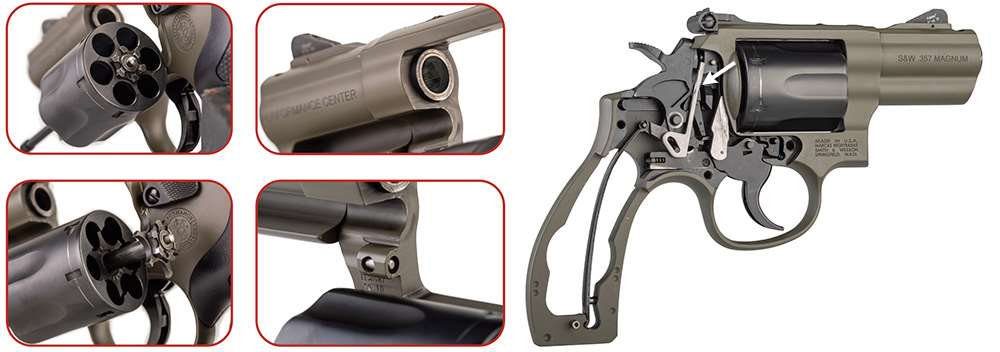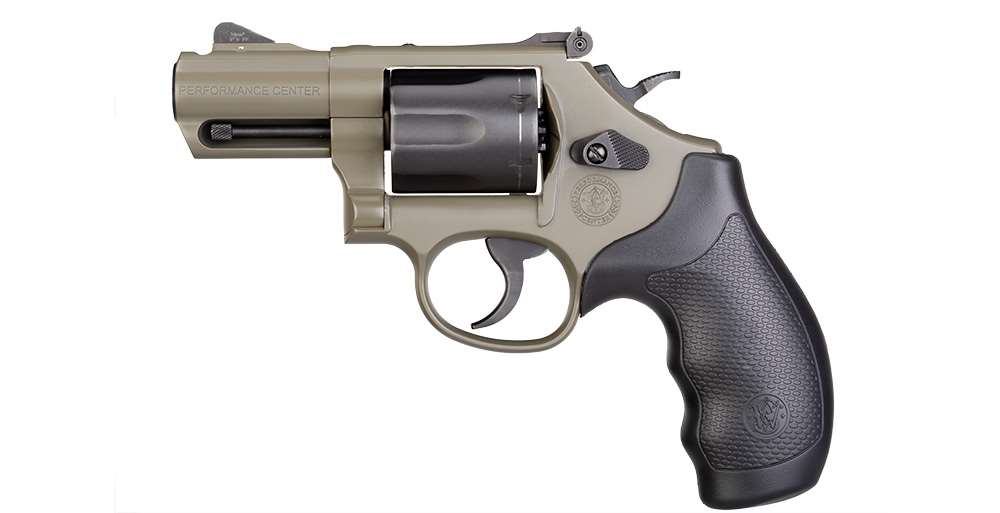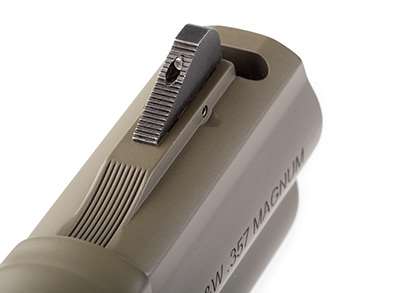The future is shaping up to be a good one for fans of Smith & Wesson revolvers. The iconic American company had released 14 new models thus far in 2025 at the time this was written mid-year. And, with one exception, they have all shared a common feature—no internal lock.
The internal lock was a feature added to the company’s revolvers after S&W leadership signed an agreement with Bill Clinton’s administration in 2000. At that time, S&W was owned by a British holding company that didn’t foresee the ramifications of its decision. As S&W was the only manufacturer in the industry that capitulated, it faced harsh criticism for what was seen as a self-serving move, and loyal customers, the firearm press and most of the rest of the industry felt like S&W had sold out. Smith was subsequently sold to Saf-T-Hammer, an American company that specialized in making safety products and firearm locks. Curiously, S&W’s new leadership decided to install the internal lock, despite the incoming Bush administration’s decision to not hold them to the conditions of the draconian agreement.
By late 2001, revolvers were shipping with the new internal lock placed above the thumbpiece, and it was hard to ignore. It was also unattractive, and the revolver’s classic lines had to be altered to accommodate it. Then, when rumors circulated that failures were being experienced, the volume of the negative noise went up. The locks’ detractors were venomously vocal, and the “feature” was branded with many unbecoming nicknames including “the hole that lets the revolver’s soul leak out.” It didn’t help that S&W chose to sell a few select J-frames built with leftover pre-lock frames. This lent credence to the argument that the lock was unnecessary. Not only was it generally regarded as an ugly reminder of an ill-advised decision, it was one that could fail at the worst of times, and it wasn’t required by the government or even the lawyers. Many longtime enthusiasts reacted by refusing to buy S&W revolvers while the lock remained.
For a long time, there was no change in the status of the lock, until 2024, when distributor Lipsey’s partnered with S&W to bring out the J-frame “Ultimate Carry” (UC) revolvers. One of the features specified by Lipsey’s product development head Jason Cloessner was a frame with no internal lock. Andrew Gore, then S&W’s handgun project manager, agreed that the lock needed to go. They were able to convince company President Mark Smith that it was time to phase out the internal lock, and the UC revolvers were a smashing success that added momentum for the future. Lipsey’s is responsible for eight of the 14 new guns introduced this year—with new variations on the Ultimate Carry J-frames (SOA commemoratives and .32 H&R Mag.-chambered models with titanium cylinders) and the long-awaited return of the Mountain Guns. The first ones debuted at SHOT Show with a .44 Mag. Model 629 and a seven-shot, L-frame 686+. The latest Mountain Guns are in chamberings not seen before: an N-frame Model 610 in 10 mm Auto and a K-frame Model 617 in .22 Long Rifle.
The author found the Power Port vent cut into the barrel and shroud of the Model 19 Carry Comp Moss to be very effective at taming the recoil of full-power .357 Mag. loads.
Smith & Wesson also released Classic versions of the Model 10, 19 and 36 at SHOT, and a black stainless variant of the popular 640 Pro Series came soon after. Smith then put out limited editions of two Performance Center guns finished in a Moss Green Cerakote. One was the N-frame Model 327 TRR8 (the only new release to maintain the internal lock); the other was the Model 19 Carry Comp with a 2.5″ barrel. It was offered without the lock and is the focus of this feature.
The compensated, short-barreled Model 19 dates back 30 years to the “K Comp” of 1994. It was well received as a serious carry revolver; the compensator port reduced felt recoil and muzzle rise and allowed faster follow-up shots with blistering magnum ammunition. The first one featured a 3″ barrel. Smith discontinued the Model 19 in 1999, and it remained absent from the catalog for two decades. The Model 19 Combat Magnum comeback tour of 2018 featured a re-designed 4″ gun with classic lines as well as a “Carry Comp” 3″ gun. Since then, the Carry Comp has also been offered with a 2 1/2″ barrel—such was the one I tested.
Inspecting the gun upon its arrival, the finish, evenly and flawlessly applied, was a shade or two lighter in hue than olive drab. The color contrasts nicely with the matte black of the sights, cylinder, trigger, hammer and screws. The gun shipped with two sets of stocks: the Altamont Rosewoods that were on it and a pair in black synthetic with finger grooves. The company’s listed 2.5″-barrel spec includes the power port, so actual barrel length before the unrifled port chamber is about 2 1⁄8″. The words “Performance Center” claim the space on the left side of the barrel shroud and “S&W .357 Magnum” adorns the right side. The Performance Center logo lies below the cylinder release on the left side of the frame. For the first time in 25 years, the area above the thumbpiece is clear of any holes or engraved directional arrows.

The Model 19 Carry Comp Moss exhibits precision in the details, including: (far l., clockwise) the chamber mouths, forcing cone, yoke detent and extractor star. The new drop safety lies behind the hammer in this view (above), but note the hammer block (arrow).
As to other appearance notes, the hammer is of the now-familiar teardrop shape, and the trigger is the smooth-faced combat style. Both parts are of MIM construction. Most earlier K Comps or Carry Comps had trigger stops (to limit overtravel) attached to the back of the trigger—this one does not. The sights were “standard issue” for Carry Comps: a black serrated ramp (0.230″ tall) with a small tritium dot up front and an adjustable rear with a shallow window. The port’s vent sits just in front of the front sight with a single opening measuring 0.45″ wide and 0.20″ front to back.
The gun utilizes the ball-detent lock-up system designed by engineer Brett Curry for the Stainless Combat Magnum of 2014. This design eliminates the contact point at the front of the extractor rod where it meets the locking bolt; instead, a spring-loaded ball on the frame locks into a detent on the yoke. This setup is stronger than the old style. Eliminating the locking bolt also allows a full-length extractor rod to be housed in the milled cutout of the barrel shroud. The re-designed yoke allows room for an enlarged and fully round forcing cone, addressing a weak point in older K-frames. Curry’s design improvements, combined with the endurance package modifications of 1998, greatly enhanced the durability of K-frame revolvers. I had assumed that the barrel would be a one-piece forging with the “Power Port” vent cut by way of electrical discharge machining (EDM). Closer inspection revealed the barrel was actually of two-piece “shroud and sleeve” construction like contemporary Model 19 and 66 Combat Magnums—an impressive display of design and intricate machining.

Smith & Wesson is once again manufacturing some of its revolver models without the nearly-universally-derided internal lock. Note the differences between the No Internal Lock revolver reviewed here (l.) and an older model with the lock raised and a key hole visible above its cylinder release (inset). The revolver comes with sets of both Altamont Rosewood and black synthetic stocks (r.), both of which feature finger grooves.
Handling the gun revealed positive function and lock-up. The front of the cylinder was pleasingly beveled, and the tip of the extractor rod was smooth and radiused. The extractor provided an exceptional 9/10″ of throw when fully depressed. Dry-firing the gun in double-action was underwhelming. The pull was heavier than I was expecting for a Performance Center gun, with a definite hitch toward the end of its travel; it averaged 11 lbs., 14 ozs. A drag mark was evident on the back of the cylinder where the cylinder stop notches rolled across the cylinder stop. Such marks are unusual on a new gun. The single-action pull was good, breaking crisply at an average weight of 4 lbs., 8 ozs. I decided to swap the Altamont wooden stocks for the synthetic ones in anticipation of a high-round-count day at the range. Removing the stocks revealed that the Carry Comp sports a bossed mainspring, as is common with PC guns. The strain screw must have been AWOL on Cerakote day; it was a shiny stainless one. Not a big deal, as both pairs of OEM stocks covered the frontstrap—something to be aware of if one planned on using Magna-style stocks with the frontstrap open.
The American Rifleman protocol for testing a revolver with a barrel of this length called for groups fired at 7 yards. The rear sight was bottomed out on the frame from the factory, so several elevation adjustments were made during the first groups fired. A full 18 tactile clicks “up” were applied to get 125-grain bullets close to the point of aim. A few clicks of right windage were also dialed to correct for bullets impacting left of the point of aim. The Carry Comp was benched on an impromptu padded rest and groups were fired double-action. The first rounds recorded were Federal’s .357 Mag. 158-grain JSPs. Shooting magnums from a short-barreled revolver subjects the shooter to a significant amount of muzzle blast that takes some getting used to. The port of the Carry Comp sends some of that blast straight up, which is a little different sensation than when it just exits the muzzle and barrel cylinder gap. It makes the blast more noticeable, but the reduction in felt recoil was immediately apparent. I was impressed with how much the magnums were tamed by the Power Port vent.

Wearing rubber stocks, and sporting the contrasting color scheme of a black cylinder and controls on a green frame, the Smith & Wesson Performance Center Model 19 Carry Comp Moss is a visually appealing revolver with modern lines.
Something else became quickly apparent as I shot the Carry Comp. The sights didn’t agree with my aging eyes. The front sight is 0.13″ wide, while the rear sight’s opening is about the same width. The 3.9″ sight radius and the shallow opening of the rear-sight window made getting a clear sight picture nearly impossible for me, even in bright sunlight. When this sight combination was selected for the revolver 30 years ago, I could’ve probably made them work—not so much these days—but the gun shot well despite the “old guy” eyes and the heavy DA trigger.
I fired SIG’s 125-grain JHP load next, and the Power Port continued to work its magic. Recoil was very manageable, and the blast seemed less oppressive than with the heavier Federal load. Even from the short barrel, the SIG ammunition achieved impressive velocity and produced the smallest group of the day, putting five rounds into just less than 0.6″. Remington’s +P 125-grain .38 Spl. Golden Saber JHPs also performed well, yielding high and consistent velocities from the Carry Comp. It shot the best groups, averaging just over an inch. The load was enjoyable to shoot and would be a superior choice for recoil-sensitive shooters using a gun like this. After firing 75 rounds, I brushed underneath the extractor star and the area behind the cylinder (bolster face) with a bristled nylon brush. This minor bit of preventive maintenance was all the gun needed to operate smoothly through the remainder of the range session.

The blade of the serrated ramp front sight is pinned to a rib that is integral to the barrel shroud. Note also that the shroud features a compensating vent immediately behind the muzzle, which helps to tame the Model 19’s bite.
I then put myself through Tom Given’s Baseline Skills Assessment Drill that consists of 20 rounds fired from 5 to 10 yards on a B-8 repair center. It incorporates a draw, shooting with the dominant and non-dominant hand only, and an empty-gun reload in five stages. I was a little late on the first stage (draw and fire five rounds in five seconds at five yards), taking 5.71 seconds to complete it. I made time on the remaining stages, including the reload stage, and shot a 192/200 on the course. Two hits strayed out into the 8-ring of the B-8, both of which resulted from the one-handed shooting. The gun continued to perform well stretching the distance to 15, 20 and 25 yards on IDPA silhouette targets. I shot both magnums and +P .38s for this; the Carry Comp would hold “minute of fist” at 20-25 yards when I did my part with the trigger, even with the fuzzy sight picture. The gun went through 165 rounds throughout the testing day, igniting and ejecting each one reliably.
It felt like the Power Port was more effective with the magnum rounds. The recoil of +P rounds felt like +P rounds fired from non-ported guns. That’s subjective, but the port was doing exactly what I would’ve hoped and made .357 Mag. loads viable in a K-frame snubbie. The synthetic stocks covered the grip tang (backstrap) with spongy material and paired well with the Power Port to make everything I shot through the Carry Comp controllable and non-punishing. Normally, shooting dozens of magnum revolver rounds renders my dominant hand quite stiff for a few days after shooting; that didn’t occur with the Carry Comp—which is a welcome bonus. Both sets of stocks were tested for functionality with the speedloaders that I normally use with K-frame revolvers. Barnes 125-grain XPB monolithic bullets in .357 Mag. cases were used as a “control” round. The synthetic stocks worked perfectly with Safariland Comp IIs, HKS No. 10s and JetLoaders. The Rosewood stocks worked well with the Comp II and JetLoader but were stubborn with the HKS.

S&W did away with the internal lock and closed the cutout for the “locked” flag that stuck out when the lock was activated. The frame maintains the profile needed for the lock, but the space is now used for a new drop safety consisting of a plate and a small coil spring that interacts with the same hammer that the internal lock did. Some states (such as California) have “drop tests” that require double-action revolvers to be dropped with the hammer cocked. Smith revolvers already have an internal safety in place to prevent the hammer from striking the firing pin (if the hammer pushes off from impact), but altered or lighter aftermarket rebound springs can negatively affect that safety’s function. The new drop safety is a redundant failsafe against that possibility. Considering the troubled history of the aforementioned internal lock, I presume that the new safety has undergone extensive durability testing.

Shooting the Smith & Wesson Performance Center Model 19 Carry Comp Moss was a pleasure, and I’m pleased to report that it is an extremely solid revolver. The various engineering improvements appear to make it the strongest K-frame ever, and the Power Port allows shooters to take advantage of that strength. In my opinion, the sights could use a makeover, and perhaps Smith & Wesson will focus on K-frame sights now that the J-frame sights have been improved. Either way, the fact that company leadership listened to enthusiast customers’ preferences gives cause for optimism that more good things are ahead.
Read the full article here

